Gama
JF-Expert Member
- Jan 9, 2010
- 13,266
- 4,716
Hali inaonesha kuwa kumekuwa na ongezeko la juu la vifo vya viumbe aina ya Nyangumi ambavyo vimehisiwa ni kutokana na ongezeko la vyombo vya baharini (manowali) baharini. Aidha miungurumo ya Helkopta na makombora yanayopita juu ya bahari pamoja na milipuko ya chini ya bahari inatajwa pia kusababisha vifo hivi.
How the war in Ukraine is killing marine mammals

By Alix Kroeger5th January 2023
Dolphins and porpoises have been washing up dead on the shores of the Black Sea in unusually high numbers – scientists investigating the strandings are now pointing the finger at increased Russian naval activity due to the war in Ukraine.
E
Every morning at dawn, Ivan Rusev walks along the shoreline of the Black Sea in south-western Ukraine. In the autumn, he was watching as millions of migratory birds set off for the south. The last of the pelicans departed at the end of September and they won't return until March.
While these migrations continue in their established patterns, other wildlife in this region have been greatly disturbed. In the months after Russia's full-scale invasion of Ukraine in February, Rusev noticed a new and troubling phenomenon: dolphins and porpoises were washing up dead on the beach in unusually high numbers. When he'd found dead animals here in previous years, many had marks on their bodies that suggested they had got caught up in fishing gear. These latest marine mammals had none.
Rusev is the head of research at Tuzly National Nature Park, in south-west Ukraine, not far from the border with Moldova. In a normal year, he says, he finds perhaps three or four dead dolphins along the 44km (27 miles) of shoreline in the park. Once the war began, most of the shoreline was closed by the military.
Between 24 February 2022 and the end of August, he and his colleagues discovered 35 dead cetaceans along the 5km (3 miles) of shoreline still accessible. His team spoke to their counterparts in other Black Sea countries, except Russia and Georgia. Some of Ukraine's national parks, including one near the devastated city of Mariupol, are now in Russian occupied territory. Rusev's team couldn't reach any of their colleagues there.
When they put all the numbers together, 2,500 dead dolphins had been reported to have washed up on shore by May 2022. But because most dead dolphins simply sink to the bottom of the sea and are never counted, Rusev believes the actual number is much higher.
Other organisations around the Black Sea have also noticed an increase. Mare Nostrum, a Romanian association of environmental specialists, says it has registered the highest number of stranded cetaceans since at least 2010. Marian Paiu, executive director of Mare Nostrum, says they had recorded 194 individual animals stranded between January and the end of September. In most years, they record fewer than 100.
The main culprit, Rusev argues, is acoustic trauma from the increased use of sonar by mainly Russian submarines.

More than 2,500 dolphins had washed up by May this year – significantly more than happens typically for the period (Credit: Getty Images).
"When dolphins obtain this pressure from sonar, it destroys the acoustic system fully. He [the dolphin] has no possibility to navigate himself, so he has to struggle and probably to crash... [We] just saw dolphins without any marks. When we saw dolphins before [the] war, we saw [marks] from the net on the body or cutting fins," he says.
Dolphins and porpoises use ecolocation – a biological form of sonar – to navigate and communicate, whistling, squeaking, buzzing and clicking their way through the water. There's now considerable evidence to suggest a link between the naval use of sonar and acoustic trauma in cetaceans.
In 2000, after a mass stranding in the Bahamas, the US Navy determined for the first time that the cause was sonar used in exercises. Researchers found that the largest mass stranding event in the UK, in Cornwall in 2008, was probably caused by naval activity. At least 26 short-beaked common dolphins died in the incident after international naval exercises, including the use of mid-frequency sonar, had taken place nearby just four days earlier.
But military secrecy has sometimes impeded research on the problem. In a 2021 status report, Accobams (the Agreement on the Conservation of Cetaceans of the Black Sea, Mediterranean Sea and Contiguous Atlantic Area) concluded: "It is difficult to provide a clear picture of the situation concerning the use of naval sonar in the Accobams area due to the confidential nature of military operations, except than exercises involving sonar and anti-submarine warfare training continue to occur in deep-diving cetaceans habitat hotspots, occasionally with lethal consequences."
For some experts, the coincidence of dolphin strandings in the Black Sea with the Russian invasion of Ukraine is too great to ignore.
"It's very significant that mass strandings began almost immediately after the Russian attack," says Pavel Goldin, of the Schmalhausen Institute for Zoology, which is based in Kyiv. He confirms the pattern of significant mass strandings began almost immediately after the Russian attack. "We take seriously the hypothesis of acoustic trauma. We've put much effort into detecting and researching acoustic trauma."

The degree of damage to the Black Sea ecosystems may not be fully understood until the conflict is over (Credit: Getty Images).
It's one thing to suspect that acoustic trauma, whatever the cause, may be to blame for the dolphin deaths – it's quite another to prove it. Damage to the inner ear of cetaceans can only be detected in samples examined within 24 hours of death, otherwise it becomes impossible to distinguish between damage to the sensitive hairs of the inner ear and post-mortem decay. Most dolphin carcasses only wash up on shore much later, when they've already started to decay. The specimens must then be sent to laboratories in Italy or Germany for necropsy. (Read more about how scientists determine cetaceans' causes of death.)
"Usually the sonar is not directly killing them, but it is leading to damages to the inner ear, which as a result is limiting the ability of the animal to get orientated, to feed," says Dimitar Popov, project manager for the conservation of cetaceans at Green Balkans, a Bulgarian non-profit. "Usually they can either get stranded alive or just die of hunger."
However, there's another element that points to sonar's role in the strandings, Goldin says. In addition to the dead dolphins, there were at least two live strandings on the Ukrainian coast this year. After a day or so, the animals recovered and returned to sea. In some cases, research indicates it's possible for the damage caused by over-exposure to sonic trauma to be reversed. If a stranding is caused by disease or an infection, the cetacean normally dies.

Submarine missiles, helicopter motors, underwater explosions and mines can all cause acoustic trauma to cetaceans (Credit: Getty Images).
When full-scale war broke out in February, the Black Sea was one of the focal points. Russia views the Black Sea and its warm-water ports as essential to its security. After the collapse of the Soviet Union in 1991, Moscow leased the Crimean port of Sevastopol – home to the Russian Black Sea Fleet – from Ukraine. Russia occupied and annexed the Crimean peninsula in 2014.
The Black Sea Fleet is far bigger than Ukraine's modest navy. The Royal United Services Institution (Rusi), a security think tank, says Russia's six Black Sea submarines "substantially outmatch the regionally deployed subsurface assets" of other navies in the region. The submarines have fired at Ukraine – an additional source of acoustic disturbance, along with helicopter motors, underwater explosions, and mines. Russia has fired hundreds of missiles from the Black Sea, and any that fell in the sea would have displaced cetaceans, Popov says. In spring, he and his colleagues recorded the highest density and abundance of cetaceans off the Bulgarian coast for six years.
"The animals… are distributed in a pattern," Popov says. "This pattern has been broken and they move further south. That's why in Bulgarian waters, there was such high density." That additional density also made it easier for diseases to spread, he adds.
On the first day of the invasion (24 February), the Russian navy moved immediately to seize Snake Island, 50km (31 miles) offshore from Tuzly National Nature Park (the defiant response from Ukrainian border guards became a meme and eventually a commemorative stamp). Ukraine sank the Moskva, a guided-missile carrier and flagship of the Black Sea Fleet, in April and retook Snake Island in June.
It's this area that Rusev wants Ukraine to designate as a protected area, a maritime national park of about 5,000sq km (1,930sq miles), where dolphins would be protected. He has submitted a proposal to the ministry of environment, which has given its backing to the idea.
In a statement, the ministry told BBC Future it was already thinking about how to restore the dolphin population and establish the Black Sea afalina (bottlenose) dolphin readaptation centre in Tuzly national park.
"Every year, the centre will be able to rehabilitate dolphins, as well as receive scientific data on the life of dolphins and ways to preserve their populations," a ministry spokesperson says. "The concept envisages establishing international cooperation, as well as changing the paradigm of attitude towards dolphins through educational activities. The centre will become a tourist location and annually (seasonally) visitors will be able to observe dolphins outside the dolphinariums."

Ivan Rusev wants to a maritime national park to be established in the Black Sea near Snake Island, protecting the area's cetaceans (Credit: Getty Images)
Until the Russian invasion of Ukraine, the recovery of cetacean numbers in the Black Sea counted as something of an environmental success story. There are three main species: the common dolphin, harbour porpoise and bottlenose, or afalina dolphin. Until the 1960s, populations were in decline. It's difficult to pin down historical figures, but scientists interviewed for this article estimated there were probably between one million and two million dolphins and porpoises in the Black Sea in 1900. By 1945, they estimate that had dropped to about 100,000. Hunting was the biggest threat but in 1966 it was banned in the Soviet Union (including Russia, Ukraine and Georgia), Bulgaria and Romania. Turkey followed suit in 1983.
Other threats remain, including bycatch and pollution. One of the peculiarities of the Black Sea is that it is technically dead below a depth of about 180m (590ft): no oxygen gets through to its depths. Marine life is concentrated in the upper stratum. "Having in mind that 87% of the sea water is naturally anoxic, the Black Sea is highly sensitive to anthropogenic impacts due to the huge catchment area and almost landlocked nature," according to the UN Environment Programme.
The most authoritative survey to date was carried out in 2019 by Accobams. It estimated there were about 253,000 cetaceans in the Black Sea: 118,328 common dolphins; 94,219 harbour porpoises (probably an underestimate); and 72,369 bottlenose dolphins. The survey covered nearly all of the Black Sea, except for an area around Russian-occupied Crimea. Despite the partial recovery in numbers, all three species remain on the red list of threatened species maintained by the International Union for the Conservation of Nature (IUCN).
On paper, at least, some parts of the Black Sea are already protected: there are 13 patches designated as Important Marine Mammal Areas by the IUCN. Bulgaria has some 15 Marine Protected Areas recognised by the EU, with another three awaiting approval, while Romania has two. Turkey, which is officially a candidate for EU membership, also has six sites designated under the Ramsar convention. In practice, enforcement is lacking.
"Protected species are very well-protected – on paper," says Goldin. "Enforcement is always problematic. The Black Sea is even more problematic because of illegal fisheries in the region. So much of the fishing is out of sight that it's hard to assess, control and fight against it."

It is not only cetaceans that are facing pressure in the Black Sea – fisherfolk have also reported there are fewer fish (Credit: Getty Images)
Popov, who has worked for 20 years on the Bulgarian coast, also criticises the failure of environmental authorities to take action on damages to wetlands and cetacean bycatch, primarily in the turbot fishery.
Even if Rusev succeeds in winning official support for his idea of a marine national park, other difficulties remain. Dolphins and porpoises migrate over large areas. Paiu says an official designation is a starting point but not enough on its own.
"What are you doing in terms of management and monitoring of the species? Because in this, from my point of view, the alternatives are a bit lacking… These MPAs are not so large: we're talking about marine mammals, which are very mobile species. And you can imagine an MPA that has a width of 4km (2.5 miles), it's not really an MPA that could provide the conservation purpose for these animals," he says.
Another major issue is corruption, which has hampered conservation efforts around the Black Sea: Bulgaria and Romania, along with Hungary, have the lowest rating among EU countries on the Corruption Perceptions Index run by Transparency International, an anti-corruption non-profit. Ukraine does even worse: it's ranked 122nd out of 180 countries on the index. Rusev is optimistic that the spirit of change in Ukraine brought about by the war will lead to a new intolerance of corruption.
"When I was the director [of Tuzly national park], I saw how some guards gave permission to poachers, and sometimes they extracted tonnes and tonnes of fish… I hope that after the war, it will be absolutely abnormal for the guards to be corrupted," he says.
The full extent of the damage done to the Black Sea and its marine wildlife will only become clear once the war has ended, and there's no sign that that will happen soon. For now, it's simply too dangerous for scientists to carry out research. Many of the shells fired by Russian artillery shells landed on coastal wetlands, creating deep craters. Those that failed to explode remain a hazard. In addition, both sides laid mines at sea; these could take decades to clear.
"At least on our shores, besides the mines that are floating… we didn't record any other changes in the quality of water, for example, or species. The only thing that kept reaching my ears, it's the fact that fishermen are lacking fish. They are complaining for several months now that the quantities and the [number of] species are dropping," Paiu says.
Mare Nostrum has had to put some of its surveys on hold, some of which had taken several years of planning. Even once scientists can start work again, there will necessarily be some gaps in the data. It's a discouraging outlook for the researchers who have spent years building up a picture of the complex and diverse ecosystems around the Black Sea.
"I'm very afraid we'll discover the gravest threats when [the war] ends. It's very clear we're just in the middle of the process," Goldin says. "I'm very afraid tomorrow or the day after we'll find the deadliest impacts of the war."
--
Join one million Future fans by liking us on Facebook, or follow us on Twitter or Instagram.
If you liked this story, sign up for the weekly bbc.com features newsletter, called "The Essential List" – a handpicked selection of stories from BBC Future, Culture, Worklife, Travel and Reel delivered to your inbox every Friday.
How the war in Ukraine is killing marine mammals
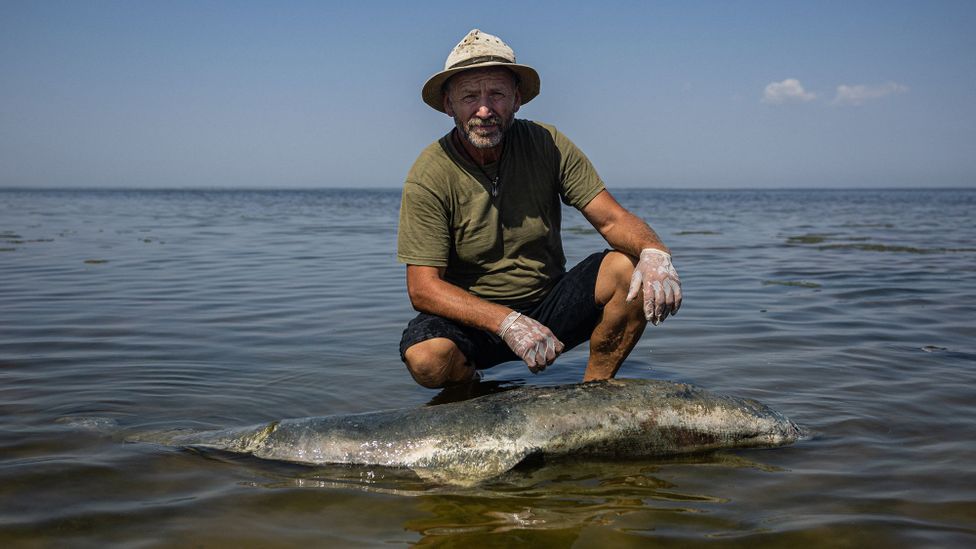
By Alix Kroeger5th January 2023
Dolphins and porpoises have been washing up dead on the shores of the Black Sea in unusually high numbers – scientists investigating the strandings are now pointing the finger at increased Russian naval activity due to the war in Ukraine.
E
Every morning at dawn, Ivan Rusev walks along the shoreline of the Black Sea in south-western Ukraine. In the autumn, he was watching as millions of migratory birds set off for the south. The last of the pelicans departed at the end of September and they won't return until March.
While these migrations continue in their established patterns, other wildlife in this region have been greatly disturbed. In the months after Russia's full-scale invasion of Ukraine in February, Rusev noticed a new and troubling phenomenon: dolphins and porpoises were washing up dead on the beach in unusually high numbers. When he'd found dead animals here in previous years, many had marks on their bodies that suggested they had got caught up in fishing gear. These latest marine mammals had none.
Rusev is the head of research at Tuzly National Nature Park, in south-west Ukraine, not far from the border with Moldova. In a normal year, he says, he finds perhaps three or four dead dolphins along the 44km (27 miles) of shoreline in the park. Once the war began, most of the shoreline was closed by the military.
Between 24 February 2022 and the end of August, he and his colleagues discovered 35 dead cetaceans along the 5km (3 miles) of shoreline still accessible. His team spoke to their counterparts in other Black Sea countries, except Russia and Georgia. Some of Ukraine's national parks, including one near the devastated city of Mariupol, are now in Russian occupied territory. Rusev's team couldn't reach any of their colleagues there.
When they put all the numbers together, 2,500 dead dolphins had been reported to have washed up on shore by May 2022. But because most dead dolphins simply sink to the bottom of the sea and are never counted, Rusev believes the actual number is much higher.
Other organisations around the Black Sea have also noticed an increase. Mare Nostrum, a Romanian association of environmental specialists, says it has registered the highest number of stranded cetaceans since at least 2010. Marian Paiu, executive director of Mare Nostrum, says they had recorded 194 individual animals stranded between January and the end of September. In most years, they record fewer than 100.
The main culprit, Rusev argues, is acoustic trauma from the increased use of sonar by mainly Russian submarines.
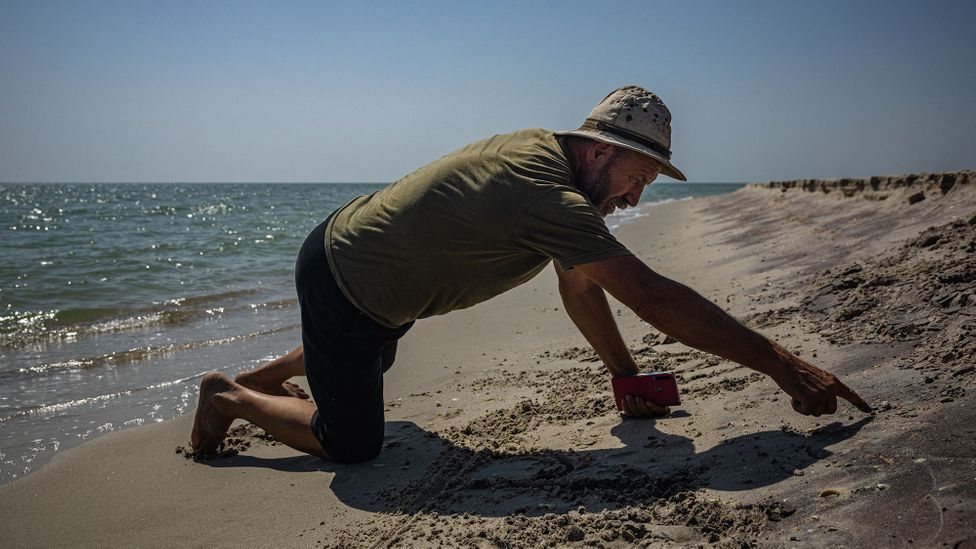
More than 2,500 dolphins had washed up by May this year – significantly more than happens typically for the period (Credit: Getty Images).
"When dolphins obtain this pressure from sonar, it destroys the acoustic system fully. He [the dolphin] has no possibility to navigate himself, so he has to struggle and probably to crash... [We] just saw dolphins without any marks. When we saw dolphins before [the] war, we saw [marks] from the net on the body or cutting fins," he says.
Dolphins and porpoises use ecolocation – a biological form of sonar – to navigate and communicate, whistling, squeaking, buzzing and clicking their way through the water. There's now considerable evidence to suggest a link between the naval use of sonar and acoustic trauma in cetaceans.
In 2000, after a mass stranding in the Bahamas, the US Navy determined for the first time that the cause was sonar used in exercises. Researchers found that the largest mass stranding event in the UK, in Cornwall in 2008, was probably caused by naval activity. At least 26 short-beaked common dolphins died in the incident after international naval exercises, including the use of mid-frequency sonar, had taken place nearby just four days earlier.
But military secrecy has sometimes impeded research on the problem. In a 2021 status report, Accobams (the Agreement on the Conservation of Cetaceans of the Black Sea, Mediterranean Sea and Contiguous Atlantic Area) concluded: "It is difficult to provide a clear picture of the situation concerning the use of naval sonar in the Accobams area due to the confidential nature of military operations, except than exercises involving sonar and anti-submarine warfare training continue to occur in deep-diving cetaceans habitat hotspots, occasionally with lethal consequences."
For some experts, the coincidence of dolphin strandings in the Black Sea with the Russian invasion of Ukraine is too great to ignore.
"It's very significant that mass strandings began almost immediately after the Russian attack," says Pavel Goldin, of the Schmalhausen Institute for Zoology, which is based in Kyiv. He confirms the pattern of significant mass strandings began almost immediately after the Russian attack. "We take seriously the hypothesis of acoustic trauma. We've put much effort into detecting and researching acoustic trauma."
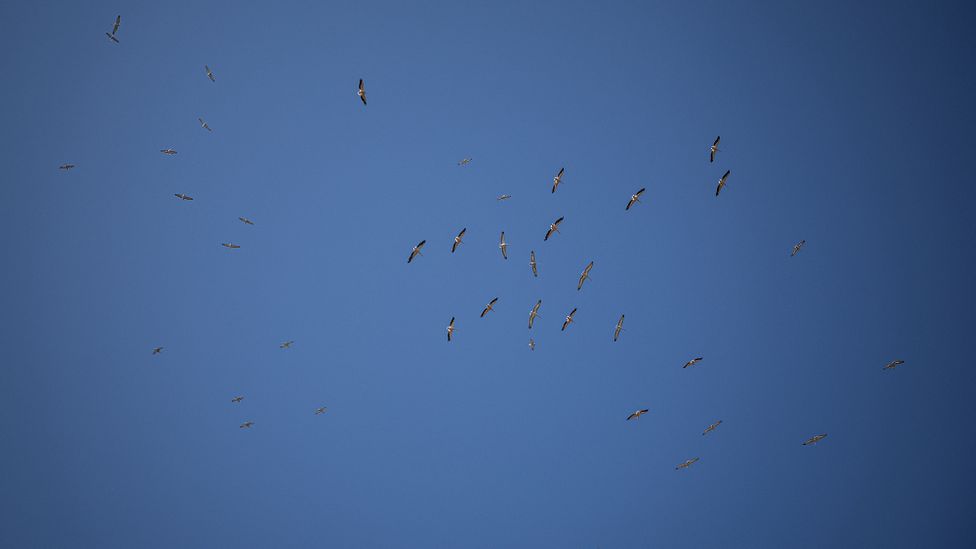
The degree of damage to the Black Sea ecosystems may not be fully understood until the conflict is over (Credit: Getty Images).
It's one thing to suspect that acoustic trauma, whatever the cause, may be to blame for the dolphin deaths – it's quite another to prove it. Damage to the inner ear of cetaceans can only be detected in samples examined within 24 hours of death, otherwise it becomes impossible to distinguish between damage to the sensitive hairs of the inner ear and post-mortem decay. Most dolphin carcasses only wash up on shore much later, when they've already started to decay. The specimens must then be sent to laboratories in Italy or Germany for necropsy. (Read more about how scientists determine cetaceans' causes of death.)
"Usually the sonar is not directly killing them, but it is leading to damages to the inner ear, which as a result is limiting the ability of the animal to get orientated, to feed," says Dimitar Popov, project manager for the conservation of cetaceans at Green Balkans, a Bulgarian non-profit. "Usually they can either get stranded alive or just die of hunger."
However, there's another element that points to sonar's role in the strandings, Goldin says. In addition to the dead dolphins, there were at least two live strandings on the Ukrainian coast this year. After a day or so, the animals recovered and returned to sea. In some cases, research indicates it's possible for the damage caused by over-exposure to sonic trauma to be reversed. If a stranding is caused by disease or an infection, the cetacean normally dies.
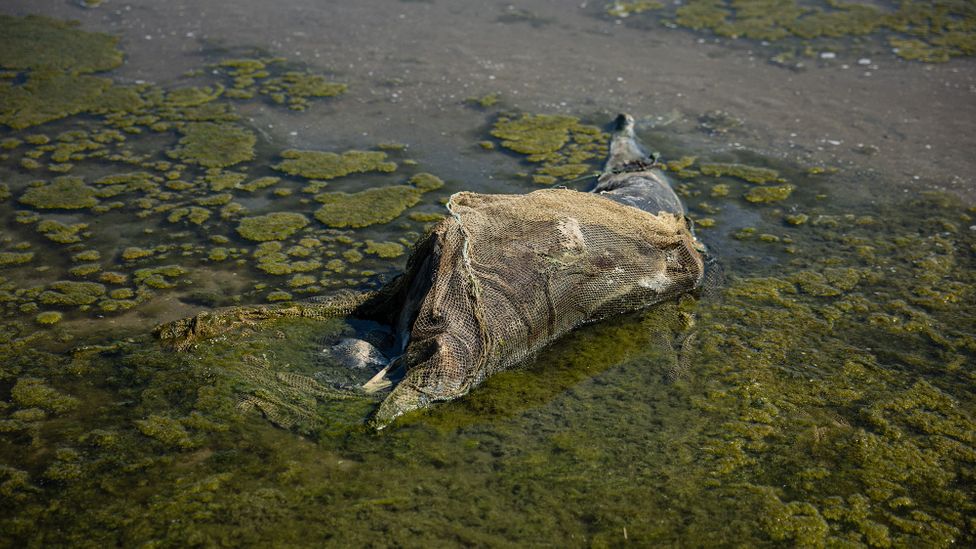
Submarine missiles, helicopter motors, underwater explosions and mines can all cause acoustic trauma to cetaceans (Credit: Getty Images).
When full-scale war broke out in February, the Black Sea was one of the focal points. Russia views the Black Sea and its warm-water ports as essential to its security. After the collapse of the Soviet Union in 1991, Moscow leased the Crimean port of Sevastopol – home to the Russian Black Sea Fleet – from Ukraine. Russia occupied and annexed the Crimean peninsula in 2014.
The Black Sea Fleet is far bigger than Ukraine's modest navy. The Royal United Services Institution (Rusi), a security think tank, says Russia's six Black Sea submarines "substantially outmatch the regionally deployed subsurface assets" of other navies in the region. The submarines have fired at Ukraine – an additional source of acoustic disturbance, along with helicopter motors, underwater explosions, and mines. Russia has fired hundreds of missiles from the Black Sea, and any that fell in the sea would have displaced cetaceans, Popov says. In spring, he and his colleagues recorded the highest density and abundance of cetaceans off the Bulgarian coast for six years.
"The animals… are distributed in a pattern," Popov says. "This pattern has been broken and they move further south. That's why in Bulgarian waters, there was such high density." That additional density also made it easier for diseases to spread, he adds.
On the first day of the invasion (24 February), the Russian navy moved immediately to seize Snake Island, 50km (31 miles) offshore from Tuzly National Nature Park (the defiant response from Ukrainian border guards became a meme and eventually a commemorative stamp). Ukraine sank the Moskva, a guided-missile carrier and flagship of the Black Sea Fleet, in April and retook Snake Island in June.
It's this area that Rusev wants Ukraine to designate as a protected area, a maritime national park of about 5,000sq km (1,930sq miles), where dolphins would be protected. He has submitted a proposal to the ministry of environment, which has given its backing to the idea.
In a statement, the ministry told BBC Future it was already thinking about how to restore the dolphin population and establish the Black Sea afalina (bottlenose) dolphin readaptation centre in Tuzly national park.
"Every year, the centre will be able to rehabilitate dolphins, as well as receive scientific data on the life of dolphins and ways to preserve their populations," a ministry spokesperson says. "The concept envisages establishing international cooperation, as well as changing the paradigm of attitude towards dolphins through educational activities. The centre will become a tourist location and annually (seasonally) visitors will be able to observe dolphins outside the dolphinariums."

Ivan Rusev wants to a maritime national park to be established in the Black Sea near Snake Island, protecting the area's cetaceans (Credit: Getty Images)
Until the Russian invasion of Ukraine, the recovery of cetacean numbers in the Black Sea counted as something of an environmental success story. There are three main species: the common dolphin, harbour porpoise and bottlenose, or afalina dolphin. Until the 1960s, populations were in decline. It's difficult to pin down historical figures, but scientists interviewed for this article estimated there were probably between one million and two million dolphins and porpoises in the Black Sea in 1900. By 1945, they estimate that had dropped to about 100,000. Hunting was the biggest threat but in 1966 it was banned in the Soviet Union (including Russia, Ukraine and Georgia), Bulgaria and Romania. Turkey followed suit in 1983.
Other threats remain, including bycatch and pollution. One of the peculiarities of the Black Sea is that it is technically dead below a depth of about 180m (590ft): no oxygen gets through to its depths. Marine life is concentrated in the upper stratum. "Having in mind that 87% of the sea water is naturally anoxic, the Black Sea is highly sensitive to anthropogenic impacts due to the huge catchment area and almost landlocked nature," according to the UN Environment Programme.
The most authoritative survey to date was carried out in 2019 by Accobams. It estimated there were about 253,000 cetaceans in the Black Sea: 118,328 common dolphins; 94,219 harbour porpoises (probably an underestimate); and 72,369 bottlenose dolphins. The survey covered nearly all of the Black Sea, except for an area around Russian-occupied Crimea. Despite the partial recovery in numbers, all three species remain on the red list of threatened species maintained by the International Union for the Conservation of Nature (IUCN).
On paper, at least, some parts of the Black Sea are already protected: there are 13 patches designated as Important Marine Mammal Areas by the IUCN. Bulgaria has some 15 Marine Protected Areas recognised by the EU, with another three awaiting approval, while Romania has two. Turkey, which is officially a candidate for EU membership, also has six sites designated under the Ramsar convention. In practice, enforcement is lacking.
"Protected species are very well-protected – on paper," says Goldin. "Enforcement is always problematic. The Black Sea is even more problematic because of illegal fisheries in the region. So much of the fishing is out of sight that it's hard to assess, control and fight against it."
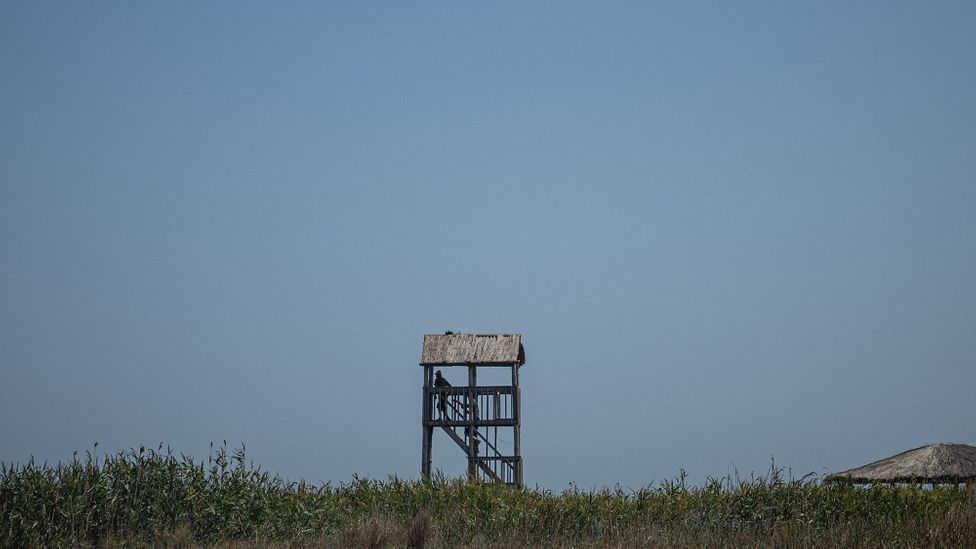
It is not only cetaceans that are facing pressure in the Black Sea – fisherfolk have also reported there are fewer fish (Credit: Getty Images)
Popov, who has worked for 20 years on the Bulgarian coast, also criticises the failure of environmental authorities to take action on damages to wetlands and cetacean bycatch, primarily in the turbot fishery.
Even if Rusev succeeds in winning official support for his idea of a marine national park, other difficulties remain. Dolphins and porpoises migrate over large areas. Paiu says an official designation is a starting point but not enough on its own.
"What are you doing in terms of management and monitoring of the species? Because in this, from my point of view, the alternatives are a bit lacking… These MPAs are not so large: we're talking about marine mammals, which are very mobile species. And you can imagine an MPA that has a width of 4km (2.5 miles), it's not really an MPA that could provide the conservation purpose for these animals," he says.
Another major issue is corruption, which has hampered conservation efforts around the Black Sea: Bulgaria and Romania, along with Hungary, have the lowest rating among EU countries on the Corruption Perceptions Index run by Transparency International, an anti-corruption non-profit. Ukraine does even worse: it's ranked 122nd out of 180 countries on the index. Rusev is optimistic that the spirit of change in Ukraine brought about by the war will lead to a new intolerance of corruption.
"When I was the director [of Tuzly national park], I saw how some guards gave permission to poachers, and sometimes they extracted tonnes and tonnes of fish… I hope that after the war, it will be absolutely abnormal for the guards to be corrupted," he says.
The full extent of the damage done to the Black Sea and its marine wildlife will only become clear once the war has ended, and there's no sign that that will happen soon. For now, it's simply too dangerous for scientists to carry out research. Many of the shells fired by Russian artillery shells landed on coastal wetlands, creating deep craters. Those that failed to explode remain a hazard. In addition, both sides laid mines at sea; these could take decades to clear.
"At least on our shores, besides the mines that are floating… we didn't record any other changes in the quality of water, for example, or species. The only thing that kept reaching my ears, it's the fact that fishermen are lacking fish. They are complaining for several months now that the quantities and the [number of] species are dropping," Paiu says.
Mare Nostrum has had to put some of its surveys on hold, some of which had taken several years of planning. Even once scientists can start work again, there will necessarily be some gaps in the data. It's a discouraging outlook for the researchers who have spent years building up a picture of the complex and diverse ecosystems around the Black Sea.
"I'm very afraid we'll discover the gravest threats when [the war] ends. It's very clear we're just in the middle of the process," Goldin says. "I'm very afraid tomorrow or the day after we'll find the deadliest impacts of the war."
--
Join one million Future fans by liking us on Facebook, or follow us on Twitter or Instagram.
If you liked this story, sign up for the weekly bbc.com features newsletter, called "The Essential List" – a handpicked selection of stories from BBC Future, Culture, Worklife, Travel and Reel delivered to your inbox every Friday.
